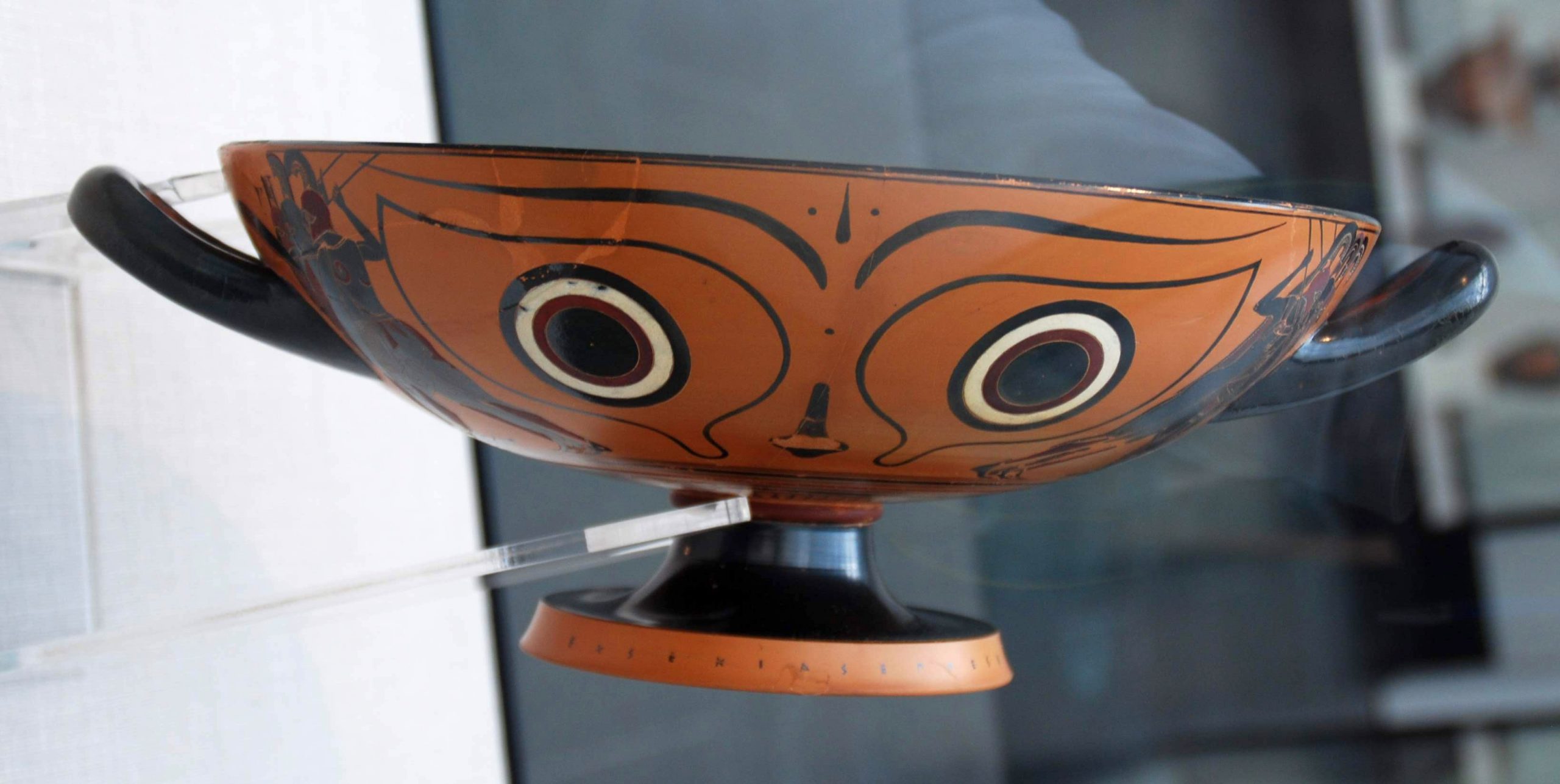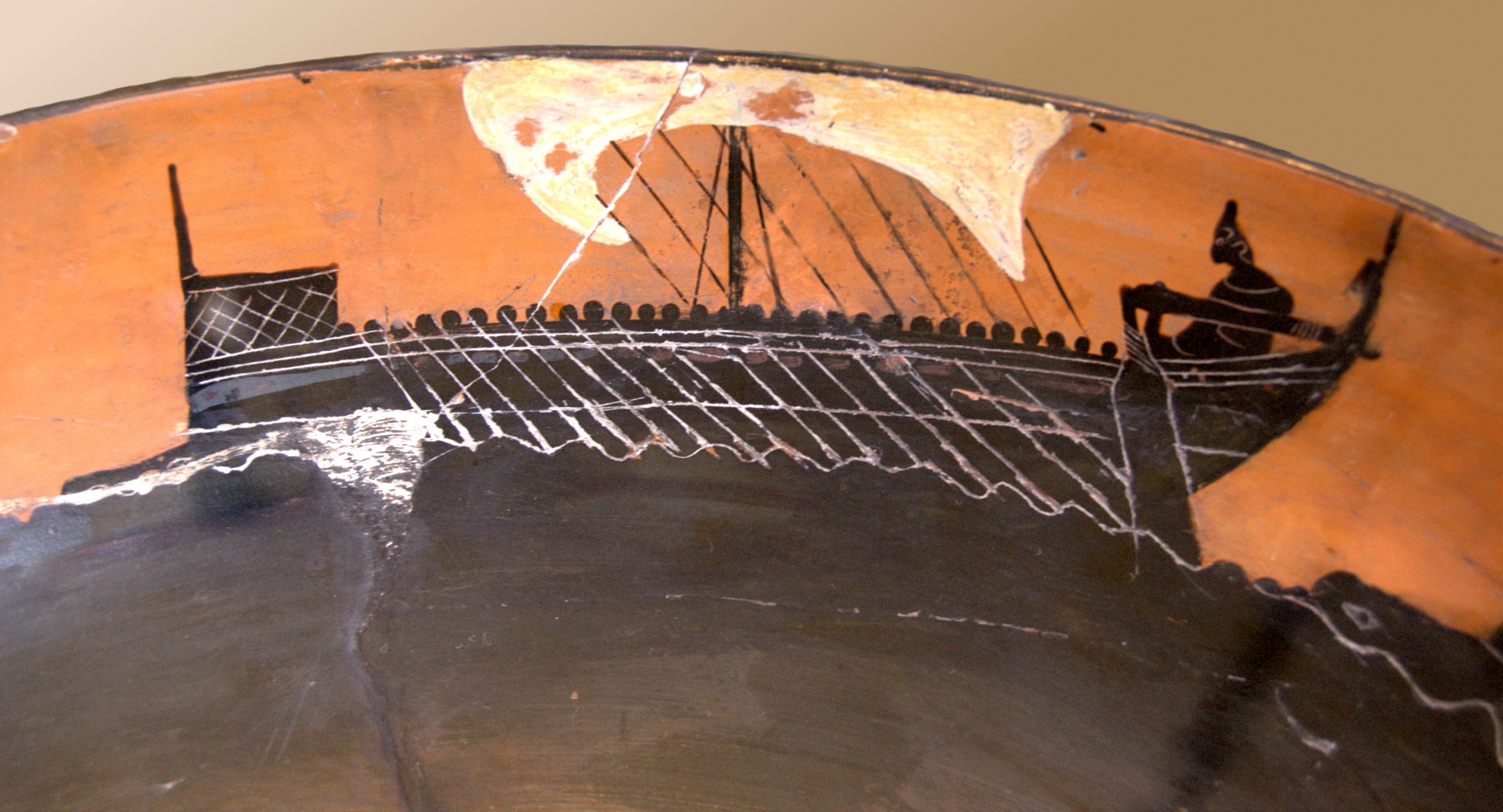The KNVTS has a proud tradition to connect its vision on the future with a view on the historic past of shipbuilding practice. Time for the chair of the KNVTS Ship of the Year Committee Rien de Meij to take a step back and reflect on the idea of “vision”. Here is the story of “The wine-dark sea”.
The vase from Cerveteri of which a detail is presented below, is dated ca. 520 BCE. The purpose of the vase was to mix wine and water for a group of merry men, sitting orderly to listen while the table is loaded with bread and meats. The cup-bearer draws wine and fills the cup for every guest at the drinking party [sumpósion].
Let’s take a glimpse over the rim of this Terracotta column-kratēr. The inside of the rim is decorated with three ships, equally spaced, the filling ornament between each two ships being a dolphin. Imagine the vase being filled with dark wine: the three ships sailing through a wavy sea, in endless pursue of each other. The wine and the painting bring to light and life the Homeric metaphor of ships on a “wine-dark sea” [oinops pontos].
The snout-shaped cutwater [steira] protrudes in front of the stem contour, lengthening the water lines and reducing the angle of entrance, making the ship qualify as “swift” [thoísin]. The stem post is straight-horned [orthokrairáon]. The sides of the red-cheeked prow have once been baptized with red wine.
The hull of this merchant ship with its large freeboard is black and huge. Horizontal white lines over the hull represent the strakes of the gunwale planking. The sail is rigged like window blinds. The brails [kálos] were made fast to the foot of the sail [histíon] and were rigged through fairleads along the forward surface of the sail. From there, they were run over the yard and to the stern. Letting out full sails is done by slackening off on every brail.
The oversized steersman [kubernētēs], seated on a bench [selma] on the raised half-deck [íkria], handles the tillers [oiáklon] of the twin rudder-oar [pēdálion] The stern post carries an in-board facing bird-head decoration [aphlaston].
Alkestis
There is a version of Euripides’ tragedy Alkestis (438 BCE) – that is played in an opera of Jean-Baptiste Lully (1674 CE) – which begins at the wedding of Admetus and Alkestis: ‘An undeclared suitor, Hēraklēs, prepares to leave Lolcos. A jilted suitor, Lykomedes, abducts Alkestis under the guise of giving a party for the betrothed couple; his escape is aided by a storm at sea: the sea-nymph Thetis, sister of Lykomedes, rises from the sea on a marine chariot and at her command the four winds start to blow. However, the wind god Aeolus calms the sea, allowing Admetus army (including Hēraklēs) to pursue Lykomedes’ ship. Hēraklēs triumphs and delivers Alkestis, but Admetus is mortally wounded.’ Artemis was involved too; at the wedding, Admetus forgot to make the required sacrifice to Artemis and found his bed full of snakes.
In this interpretation, the three ships depicted on the inside of the rim of the kratēr may represent the pursue of Lykomedes by Hēraklēs, in which Hēraklēs triumphs. The decorations on the side of the vase narrate the story of the Struggle for the Tripod: Lykomedes in a chariot, Artemis; Iolaos in a chariot, Athena; Hermes, Dionysus, gods and goddesses.
Dionysus cup
The wine in the vase will be used to fill the drinking cups of the guests at the drinking party. Such a cup is depicted in the next figure; it is the Dionysus cup [kylix] which is dated ca. 530 BCE. The front side of the cup shows how Dionysus looks you in the eyes, when you lift the cup for drinking. The backside of the vase shows a defeated person, possibly a Scythian, threatened by soldiers who are ready to kill the grounded person. The images around the handles probably depict the battles for the corpses of Patroklos and Achilles, with the naked corpse being Patroklos.

The Dionysus cup – side view focusing on the stylized face.
How would such drinking work? Trying to get the picture, you can firstly see the ships of Hēraklēs and Lykomedes sailing through the dark wine that fills a large kratēr to the brim. After the wine is poured into your kylix, the eyes of Dionysus stare at you from the side of it, invitingly. You accept the cup and while you start drinking, Dionysus breaks through the surface of the wine, sitting on a ship that travels directly towards your mouth (figure below). The drinker drinks the wine and closes in to the god who leaves him incapable of speaking letters in the right order.
Here is what Antiphanes said about it:
I’m not too drunk to think, but just enough that it is hard to form any letters with my mouth
The ship in the cup
The next image shows the decoration on the inside of the Dionysus cup. It shows Dionysus in a ship, sailing among dolphins. From the mast foot grows a vine.

The Dionysus cup – top view focusing on the ship of Dionysus.
The curves of the ship start with the silhouette of the straight-horned [orthokrairáon] stem post. The forebody then projects far forward into the shape of a snout-shaped cutwater [steira]. The pointed snout, or embolos, is decorated with a pair of eyes [ophthalmós]. The bow is fitted with a closed railing, which continuous towards aft as an open railing mounted to vertical struts. The shoulders of the ship, both fore and aft, have been decorated with a dolphin. On the cutwater we see the eyes [ophthalmós] of the ship that either look straight ahead to scare of the enemy, or look sideways to ward off the evil eye that will cause misfortune or injury.
The contour then continuous towards the aft, a slight discontinuity in the fairing of the lines, in the location where the lower contour of the snout-shaped bow moves over in the keel line, suggest that the snout-shape is an appended feature; not a part of the bare hull itself. The curved keel line runs into the rounded shape of the stern of the ship. The curve of the keel makes her more suitable for beaching stern-first than vice-versa. The stern quarter (right) carries a steering-oar and a boarding ladder [apobáthra] or lading plank . The stern post curves forward, giving the boat her characteristic scorpion-like contour.
The decorations on the Dionysus cup may help to envisage the image of the ancient Greek ship, however mostly she was a point of departure for seamen in a pensive mood, considering the pros and cons of getting drunk.
Picture (top): Detail of interior of Attic black-figured cup from Cerveteri (c. 520 BCE).
Acknowledgements
This story could only be formed thanks to the CHS Oinops Study Group of the online community for Classical Studies of The Center for Hellenic Studies, Harvard University, guided by Jacqui Donlon. Her work was published, under a Creative Commons Attribution-NonCommercial-NoDerivs 3.0 Unported license at https://kosmossociety.chs.harvard.edu/?p=11283. Where possible, the images have been selected from pictures that are freely available with open source or Creative Commons licenses.
- Figure 1 – Detail of interior of Attic black-figured cup from Cerveteri (c. 520 BCE). Boats cup, detail of the interior showing a frieze of five boats in contest. Attic black-figured cup, ca. 520 BC. From Cerveteri. Gift of the Prince Torlonia. From Wikimedia Commons. User: Bibi Saint-Pol, own work, 2007-05-31.
- Figure 2 – The Dionysus cup – side view focusing on the stylized face. Exekias, black-figure kylix, c. 530 BCE. Staatliche Antikensammlungen, München. Bibi Saint-Pol (photo, side view) Dionysus in a ship. Public domain, via Wikimedia Commons Public domain via Wikimedia Commons.
- Figure 3 – Ancient Greek ship form, depicted on a kylix (c. 530 BCE). Exekias, black-figure kylix, c. 530 BCE. Staatliche Antikensammlungen, München. Bibi Saint-Pol (photo, top view) Dionysus in a ship. Public domain via Wikimedia Commons.
- Description of the Alkestis opera: Sadie, S., Macy, L. 2009, The Grove Book of Operas. Oxford University Press.
Series of articles
 This is the fifth in a series of articles written by Rien de Meij. An abbreviated version of this article was published in SWZ|Maritime’s May 2020 issue. The other articles are:
This is the fifth in a series of articles written by Rien de Meij. An abbreviated version of this article was published in SWZ|Maritime’s May 2020 issue. The other articles are:
- “The theoretical ship” (also appeared in SWZ|Maritime’s January 2020 issue)
- “The modelled ship” (also appeared in abbreviated version in SWZ|Maritime’s February issue)
- Navigare necesse est: To sail is necessary (also appeared in SWZ|Maritime’s March issue)
- The essential ship (also appeared in SWZ|Maritime’s April issue)








